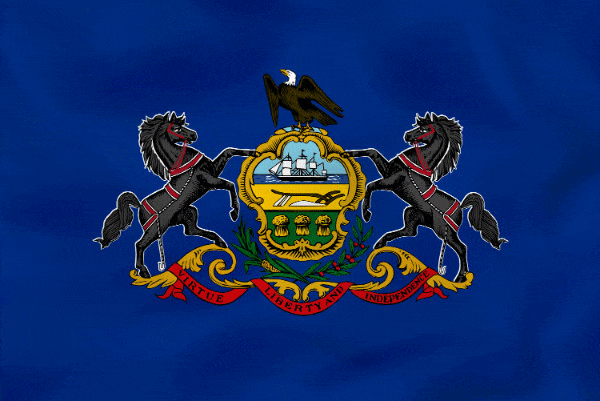Pennsylvania
State abbreviation/Postal code: Pa./PA Governor: Tom Wolf, D (to Jan. 2019) Lieut. Governor: Michael J. Stack III, D (to Jan. 2019) Senators: Bob Casey, D (to Jan. 2019); Historical biographies of Congressional members Entered Union (rank): Dec. 12, 1787 (2) Present constitution adopted: 1968 Motto: Virtue, liberty, and independence
Nickname: Keystone State Origin of name: In honor of Adm. Sir William Penn, father of William Penn. It means “Penn's Woodland.” 10 largest cities (2010 est.): Philadelphia, 1,526,006; Pittsburgh, 305,704; Allentown, 118,032; Erie , 101,786; Reading, 88,082; Scranton, 76,415; Bethlehem, 71,329; Lancaster, 56,348, Harrisburg, 48,950, Altoona, 49,523 Land area: 46,055 sq mi (119,283 km2)) Geographic center: In Centre Co., 21/2 mi. SW of Bellefonte Number of counties: 67 Largest county by population and area: Philadelphia, 1,526,006 (2010); Lycoming, 1,235 sq mi. State forests: over 2 mil. ac. State parks: 116 Residents: Pennsylvanian 2015 resident population est.: 12,802,503 2010 resident census population (rank): 12,702,379 (6). Male: 6,190,363 (48.7%); Female: 6,512,016 (51.3%). White: 10,406,288 (81.9%); Black: 1,377,689 (10.8%); American Indian: 26,843 (0.2%); Asian: 349,088 (2.7%); Other race: 300,983 (2.4%); Two or more races: 237,835 (1.9%); Hispanic/Latino: 719,660 (5.7%). 2010 percent population 18 and over: 78.0; 65 and over: 15.4; median age: 40.1. |
Rich in historic lore, Pennsylvania territory was disputed in the early 1600s among the Dutch, the Swedes, and the English. England acquired the region in 1664 with the capture of New York, and in 1681 Pennsylvania was granted to William Penn, a Quaker, by King Charles II.
Philadelphia was the seat of the federal government almost continuously from 1776 to 1800; there the Declaration of Independence was signed in 1776 and the U.S. Constitution drawn up in 1787. Valley Forge, of Revolutionary War fame, and Gettysburg, site of the pivotal battle of the Civil War, are both in Pennsylvania. The Liberty Bell is located in a glass pavilion across from Independence Hall in Philadelphia.
The nation's first oil well was dug at Titusville in 1859, and the mining of iron ore and coal led to the development of the state's steel industry. More recently Pennsylvania's industry has diversified, although the state still leads the country in the production of specialty steel. The service, retail trade, and manufacturing sectors provide the most jobs; Pennsylvania is a leader in the production of chemicals and pharmaceuticals, food products, and electronic equipment.
Pennsylvania's 63,200 farms (occupying nearly 8 million acres) are the backbone of the state's economy, producing a wide variety of crops. Leading commodities are dairy products, corn, cattle and calves, mushrooms, poultry and eggs, a variety of fruits, sweet corn, potatoes, maple syrup, and Christmas trees.
Pennsylvania's rich heritage draws billions of tourist dollars annually. Among the chief attractions are the Gettysburg National Military Park, Valley Forge National Historical Park, Independence National Historical Park in Philadelphia, the Pennsylvania Dutch region, the Eisenhower farm near Gettysburg, and the Delaware Water Gap National Recreation Area.
See more on Pennsylvania:
Encyclopedia: Pennsylvania
Encyclopedia: Geography
Encyclopedia: Economy
Encyclopedia: Government
Encyclopedia: History
Monthly Temperature Extremes
All U.S. States: Geography & Climate
Printable Outline Maps
Record Highest Temperatures
Record Lowest Temperatures
Highest, Lowest, and Mean Elevations
Land and Water Area
All U.S. States: Population & Economy
Historical Population Statistics, 1790–Present
Per Capita Personal Income
Minimum Wage Rates
State Taxes
Federal Government Expenditure
Percent of People in Poverty
Births and Birth Rates
Homeownership
Percentage of Uninsured by State
All U.S. States: Society & Culture:
Most Livable States
Healthiest States
Most Dangerous States
Smartest States
Crime Index
Residency Requirements for Voting
Compulsory School Attendance Laws
Driving Laws
National Public Radio Stations
Selected famous natives and residents:
- Louisa May Alcott novelist;
- Marian Anderson contralto;
- Maxwell Anderson dramatist;
- Samuel Barber composer;
- John Barrymore actor;
- Donald Barthelme author;
- Stephen Vincent Benét poet and story writer;
- Daniel Boone frontiersman;
- Ed Bradley TV anchorman;
- Kobe Bryant basketball player;
- James Buchanan former president;
- Alexander Calder sculptor;
- Rachel Carson biologist and author;
- Mary Cassatt painter;
- Henry Steele Commager historian;
- Bill Cosby actor;
- Stuart Davis painter;
- Kat Dennings actor;
- Jimmy and Tommy Dorsey band leaders;
- W. C. Fields comedian;
- Stephen Foster composer;
- Robert Fulton inventor;
- Grace Princess of Monaco;
- Martha Graham choreographer;
- Alexander Haig secretary of state;
- Marilyn Horne mezzo-soprano;
- Lee Iacocca auto executive;
- Reggie Jackson baseball player;
- Gene Kelly dancer and actor;
- Gelsey Kirkland ballerina;
- S. S. Kresge merchant;
- Mario Lanza actor and singer;
- George C. Marshall general;
- George McClellan general;
- Margaret Mead anthropologist;
- Andrew Mellon financier;
- Tom Mix actor;
- Kelly Monaco actor, dancer;
- Arnold Palmer golfer;
- Robert E. Peary explorer;
- Man Ray artist;
- Mary Roberts Rinehart novelist;
- Fred Rogers childrens' TV host, clergyman, and neighbor;
- Betsy Ross flagmaker;
- B. F. Skinner psychologist;
- John Sloan painter;
- Gertrude Stein author;
- James Stewart actor;
- John Updike novelist;
- Honus Wagner baseball player;
- Fred Waring band leader;
- Ethel Waters singer and actress;
- Anthony Wayne military officer;
- August Wilson poet, writer, and playwright;
- Wallis Warfield Duchess of Windsor;
- Andrew Wyeth painter.


